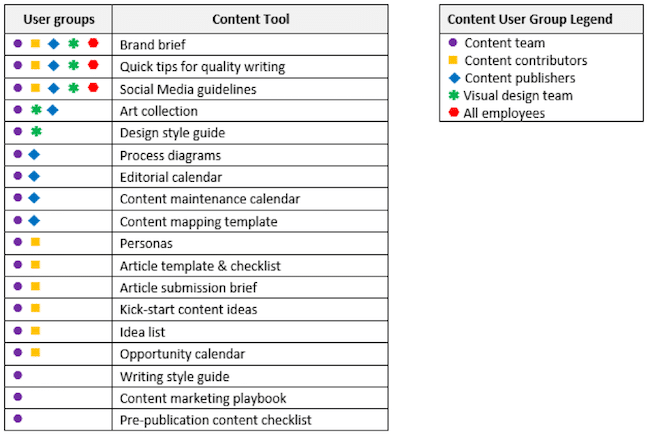
Give your content team the right tools for the job
One of the critical components in executing a content strategy is building out a tailored content toolkit. A content toolkit contains all of the supporting materials that people use at every stage of the content lifecycle. The tools in the toolkit help people to:
- Make strategic content decisions
- Follow common processes and standards
- Continually improve the impact and success of content
When planning and designing content support tools, focus on the two “A”s: audience and automation.
When designing content support tools, focus on the two As: audience and automation. Click To TweetDesign tools around the needs of users
You’re not designing a toolkit in order to cross something off your to-do list. You’re designing for an audience – the people who use the tools. Approach it as you would any other user-centred design project, with the content team being your users. Get their insights and ideas, and test the tools with your audience before finalizing them.
Make sure your content toolkit is easy to use
The days of PDFs are thankfully long gone (or should be!). Your toolkit needs to be online, integrated, and interactive. Ideally, the toolkit can be accessed by all users, everywhere, on any device. Don’t create a stand-alone tool if you can integrate it into existing technologies. For example, a workflow diagram could be considered a tool for people to follow throughout the content creation process but, if you can, why not just integrate the workflow into your content management system?
While you don’t want to use PDF as a primary format, it may be appropriate as a secondary format. For tools that people may want to print out, such as some guidelines or decision trees, it’s a good idea to also make them available in printable PDF formats.
You’ll want to assign permissions to view and edit specific content tools based on roles. This ensures that people see the tools that they need and use, without being overwhelmed by all of the tools not relevant to them. Here’s one way that we’ve assigned permissions for a recent client:
Tools for your content toolkit
Here are some ideas and definitions to get you started. Develop only the ones you need, as you need them.
Art collection: A repository for pre-approved art and images for your channels. Include any relevant licensing information.
Article submission brief: A form to collect the necessary information from content contributors who are submitting an idea for an article.
Article template & checklist: A brief outline and “fill-in-the-blanks” template to help content contributors write effective articles. Includes key concepts and a high-level checklist.
Brand brief: A one-page, high-level description of brand, voice, and personality.
Contact list: An up-to-date list of the people and roles that impact contact across different functional teams. It’s even better if it can be automatically updated as roles change and has clickable contact methods.
Content brief: A short template that outlines critical information for larger content projects. Include things like: goals, target audience, timelines, key messages, and other requirements.
Content change request form: The specific requirements of a change to existing content. Include things like: timeline, requirements, and contact information.
Content maintenance calendar: A maintenance schedule that identifies content that needs to be updated or removed. Includes a schedule and purpose for update.
Content mapping template: A template to assist the content team in identifying and communicating content mapping requirements and opportunities for new content.
Content marketing playbook: A comprehensive overview of the different types of content marketing products. Includes descriptions of content types, their purpose, key audiences, resource requirements, and position in the strategic content mix.
Content models: Content models describe the components of different content types, and articulate which of those components are required and which are optional. Models ensure that similar content types are rendered consistently.
Decision trees: Decision trees support decision-making by clearly laying out the questions that should be asked about content, and presenting the array of responses and consequences.
Design style guide: A comprehensive set of rules and guidelines for content visual design. Includes guidance for photos, images, font, and colour-schemes.
Editorial calendar: A calendar of all content approved for upcoming publication, including content requirements, responsibilities, and schedule.
Idea list: A list of pre-approved article ideas that content contributors can choose from.
Kick-start content ideas: A one-page list of idea-generating techniques to help content contributors identify and create new content ideas and opportunities.
Opportunity calendar: A tool for collecting content requests and recommended or required timelines from content contributors well in advance.
Personas: Hypothetical archetypes that represent distinct customer-groups. Each persona is a one-page fictionalized customer account derived from real customer data for that segment. Personas are used to guide content focus and decisions to ensure a customer-focused approach to content development and delivery.
Pre-publication content checklist: An extensive checklist to ensure content quality prior to publication. Includes fact-checking, link-checking, content mapping, SEO optimization, x-channel requirements and opportunities, analytic requests, multi-use idea generation, scheduled maintenance, etc.
Process diagrams: Diagrams to communicate the process flow through all stages of the content life-cycle.
Quick tips for quality writing: A one-page overview of how to ’s on quality writing standards, with examples.
RACI charts: These display clear roles and responsibilities as they relate to content. Show RACI charts for the organizational and channel levels, and include a template to help guide the development of a RACI for new projects is also helpful.
Social Media guidelines: A one-page overview of key social media concepts and guidelines, with examples.
Writing style guide: A comprehensive set of rules and guidelines for writing to quality standards. Includes sections on tone and voice, writing mechanics, information design, social media, and SEO.
Further reading
Creating content model templates for cross-functional teams
Reduce and simplify your content: a checklist
